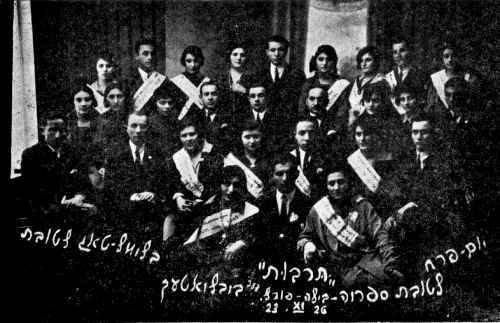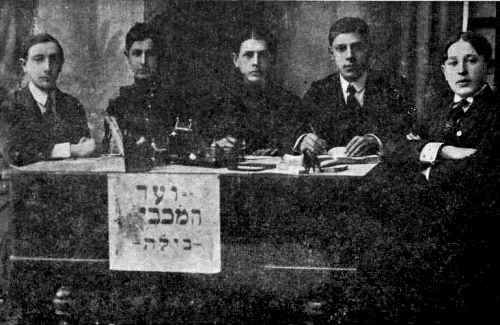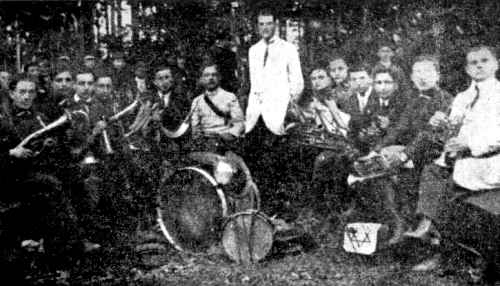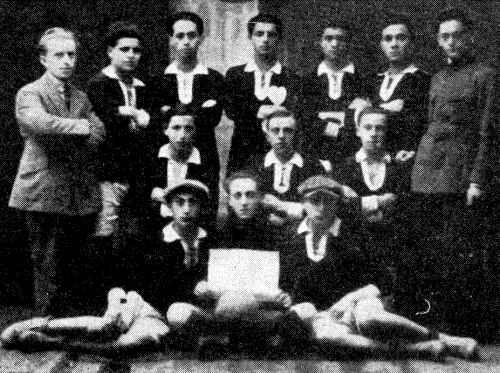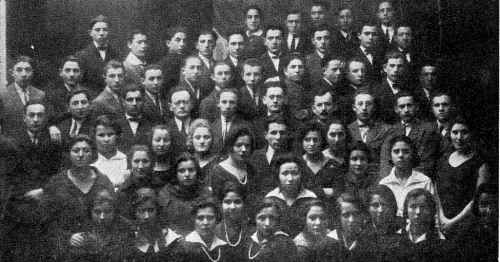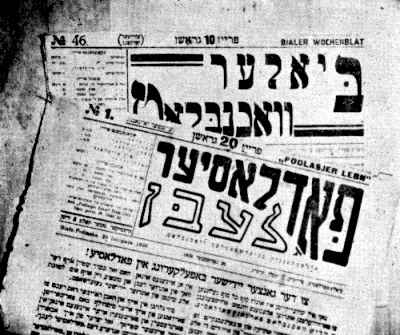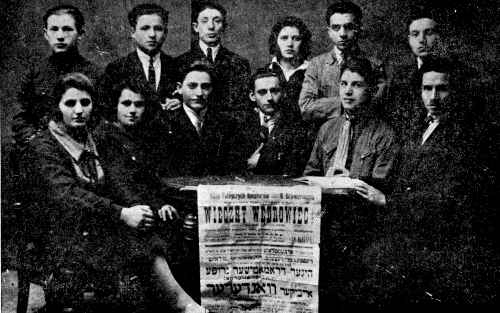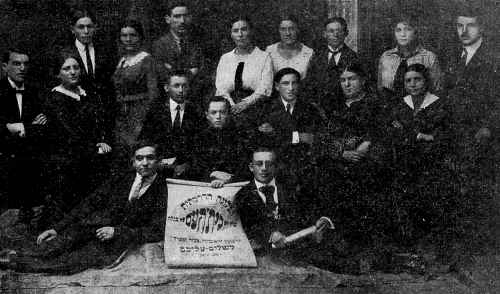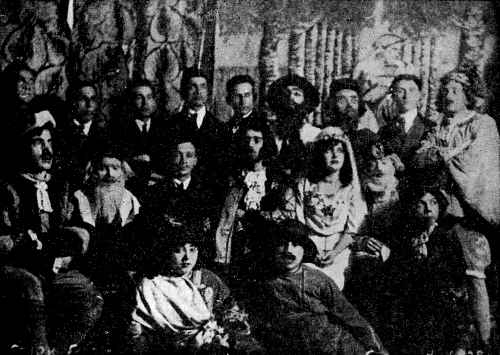[Page 234]
Evening Courses to learn Polish
by Gedalyahu Braverman
Translated by Libby Raichman
It was in the years 1905/6, when under pressure from the revolutionary movement, the Tsarist regime softened their treatment towards the Polish population a little and ceased to persecute the people for learning the Polish language.
As is known, in revolutionary circles at that time, a slogan was served to the intelligentsia of all nations that inhabited Russian territory, that they should go out to the people, engage with their problems and initiate the provision of elementary education.
The strata of Jewish intelligentsia that Biala possessed at that time, consisted of a small number of assimilated Jews. They decided to take up the call and established evening courses for the Jewish youth. The assimilated however, remained true to the cause and instead of conducting the courses in the Yiddish language, the language of the masses, they taught the Jewish youth Polish. The initiators and founders of these courses were: Dr. Gershon Zitta and his wife Byelinke, a dentist, Advocate Hartglas (the father), the manufacturer Ra'abe etc.
Most of the students consisted of Bundist youth who endeavored to convert the purpose of the courses to a meeting place where they could continue to spin the thread of Bundist activity that was interrupted by the failure of the revolution. The Bundist students enrolled to learn with the teacher Goldman, an employee at Ra'abe's factory, and an active Bundist leader.
At Goldman's lectures they were involved in political conversations and discussions. For appearance sake, their books lay open, in case of a visit by the organisers of the courses.
The young, lovely Miss Yanka Hartglas, was also a teacher of the courses (daughter of Advocate Kalman Hartglas and sister of the former representative to the Polish parliament Advocate Apolinari Hartglas). For them, this was perhaps their first contact with the local Jewish population.
Engraved in my memory is a very good impression of her attitude towards the working youth. She never gave her students the feeling that with her education, she was superior to them. She was vivacious and cheerful; by her crossing the threshold of learning, the experience became a lively and joyful one.
She approached the courses in a very serious manner, and she very much wanted us to enjoy the classes as much as possible. If she was at times, unable to attend a lecture, she would inform us in advance, and would send her younger brother as a substitute. Miss Hartglas would have conversations with us about natural science and tried very hard to influence us, to further our education.
The courses continued for two years.
An Attempt at Culture
by M. Rabon
Translated by Libby Raichman
It must have been in the years 1908 – 1910, that a group of so–called ‘children from established homes’, got together and founded a small culture group. These young boys already knew a little Russian and secular studies, that they learned from private teachers, from students at high school and from the Russian high school ln the town.
Their meeting place was in the home of the Hebrew teacher Ya'akov Shteinman, who lived in the annex of the house of Binyamin Leibele Mandelboim on Brisk Street. There they rented half a room that was separated by a screen, behind which was a small library, mainly with Russian books. The members would meet in this room almost every evening.
The library housed about 200 books – part of these were given by the members and part comprised supplements to the Russian newspaper “Ruskaya Slava” in Moscow, to which the group subscribed. The members paid a monthly contribution.
Their activities had to be conducted in secret, to avoid the eyes of the Russian police and also to avoid the neighbours, from whom the parents could find out about their meetings. For this reason, they worked out various routines to which the members had to adhere when going to their meeting place, as well as internal rules. They met only at night so that they could come unnoticed.
The group consisted of quite a small number of members. Most of the boys were between 16 and 18 years of age and
[Page 235]
also a few girls from Chassidic homes. Among others, the following were members of the group: Leibl Goldshtein, Yisroel Cohen, Dovid Lustigman, Channah Feige Mintz, Berel Ernkrantz, Manye Kashtenboim, Moshe Rubinshtein and Hinde Shachor.
The situation was more dangerous for the girls than for the boys, because imagine what would have awaited them at home if their parents found out about their meeting with boys, and also with high school students, who were certainly gentiles.
After a short time, a few Jewish high school students were drawn into the group who used to read classic Russian works aloud. Every evening one of the high school students would read the work of a specific Russian writer. Among these students, there was one named Kattelyansky,[1] a year 8 student who had a particular leaning towards humourous writers. He would lecture twice a week; one evening he would read the works of the Russian writer Gogal, and in the second – the work of Sholem Aleichem. Some of the other high school readers were: Issak Tiyamkin, Yuzshek Hartglas and Kantarovicz.
Footnote:
- He was a medical doctor in New York. He later gave up his medical practice and became a singer of Jewish folk music, of which he published a collection. Return
The “Tarbut” Library
by M.Y. Feigenboim
Translated by Libby Raichman
The “Tarbut” library was one of the finest Zionist cultural institutions in the town. Despite all the discord that existed in the Zionist camp, in this institution the gatherings were harmonious and collaborative.
To understand the origins of this library, one must return to those years when all the Zionist activity in the town was concentrated in “Bet–Am”. Already then, when “Bet–Am” was situated in Sadover Street, the library possessed a significant number of books and began to distribute them for reading. Reizl Belman and Isaac Shein were the librarians. The Zionist movement “Hashomer Hatza'ir” also had a library, an initiative of Chaim Rozmarin, that was established with a small number of books from the earlier youth organization “Parchei–Tzion”.
The library grew in size, and besides Yiddish books, it also possessed books in Hebrew and Polish. After removing the Zionist organization from its location on Sadovver Street, and the Hashomer Hatza'ir from the building of the former Folk–School on Mezritsh Street, the two libraries encountered difficulties in their activities.
|
|
Flower sellers for the benefit of the “Tarbut” library
In the first row, standing from right: Yurberg (sister of Tsirrel), Mordechai Lashtshevski, Tsirrel Yurberg, Shor, Asher Rozentzveig, Maya Batshko, Esther Zinger, Sholem Gliksberg, Chaye Rozentzveig
In the 2nd row seated from right: Chaim Rozmarin, Rayzl Belman, Chayele Fishman, Yosef Feldrib, Yisroel Goldshtein, Yitzchak (Isaac) Shein, Yonah Shein, Toybele Rubinshtein, Yocheved Biederman
In the 3rd row seated from right: Avraham Zinger, Tsharni (Hershel Shachor's daughter), Meilech Rozmarin, Blumme Zilberzon, Beile Milboim, Leibl Bialar, Moshe Orlanski
In front: Kanakshrein, Yerucham Lipyetz, Dintshe Cohen |
[Page 236]
Then the idea arose of merging the two libraries, an idea that was actually accomplished. The library that was called the “Tarbut Library” was run by representatives of the General Zionists and Hashomer Hatza'ir.
Thanks to the determined efforts of the chairman of the “Tarbut” organization, Yaakov Aharon Rozenboim, they managed to find premises in the communal house of Tille Berlin on Valnoshtshi Square. Now the activities of the institution actually proceeded normally and very intensively.
For some time, the library was managed by Yosef Feldrib, who with his devotion and his energetic activity, increased the number of books considerably.
Aside from the fee charged to the readers and various undertakings, other sources of income were: theatre presentations, lectures, flower selling and subsidies from the community and from the town council.
When the libraries were combined, it was decided that it would house books in three languages. It continued in this way, until the end. In order to differentiate between the different language books, the Yiddish books were bound in green covers, the Hebrew books in blue, and the Polish books in black.
The librarians who were active there were, among others: Mulye Urbacher, Yehoshua Kligger, Itke Rubinshtein, Asher Rozentzveig, Asher Greenblat and Sheindl Grodner.
In 1933 there were 2385 books in the library. Of them: 1170 were Yiddish books, 405 Hebrew books and 810 Polish books. The number of readers amounted to 200 (according to “Podlassier Life” number 18, of the 12th May 1933).
During the war, when the premises of the Library initially housed refugees, the “Tarbut” chairman Yaakov Aharon Rozenboim moved the books to the premises of the Judenrat on Brisk Street, and he took care of them so that the book–treasure would not be pillaged.
After the liberation of Biala from German occupation in 1944, the few Jews who remained alive, returned to the town and found no trace of the “Tarbut” library. The Christian merchants would wrap their merchandise in pages of the Exodus from Yiddish religious books and other books that had been in the library.
The Bundist Library
by Gedalyahu Braverman
Translated by Libby Raichman
The “Bund” had a tradition of organizing gatherings on the fast day of Tishah B'Av [9th Av], when people did not work. At one of these gatherings in 1905, Eliyahu Shimshelles (Yustman) proposed the establishment of a library. His proposal came primarily, to maintain the existence of the Bundist movement in the town, as there was then a crisis due to the decline of the revolutionary movement in Russia.
From the fees of the members and from the money that was collected, a few books were purchased, written by the following authors – Mendele Mocher Sforim, Sholem Aleichem, Y. L.Peretz and Sholem Ash.
The books were legal but utilizing the books to establish a legal public library was prohibited in Tsarist Russia; so, the books were exchanged among the readers in an illegal manner.
A while later, when various active members dispersed, the books were moved to Eliyahu Klotz and to me. We became the actual managers of the wandering library. To this work we attracted the following members: Shimon Blankleider, Moshe Binyomin Tsharni, Yoel Fingerhut, Betzalel Birnboim and others.
As its first task, the group set out to increase the number of books. In order to procure proper funding, we relied upon their original existence.
At that time, a cinema already existed in Biala, in the home of Chaim Kashtenboim, that was called “Illuzion”. From time to time we would rent the premises from the proprietor of the cinema for an evening and then went out into the town selling tickets for the cinema show. This brought us certain profits and afforded us the possibility of buying new books. We would also organize lotteries for the purpose of buying books and utilize the festival of Purim, when donations were distributed, and our members would go around in disguise, collecting for the illegal library.
When we already had a larger number of books, we found an old Jewish lady, who agreed, for a certain fee, to keep the books at her place, on condition that only the books would be kept there and that no one should come there, except for the members that she knew. It was further suggested that we carry the books under our clothes and in this way, we exchanged the books among the readers.
In the last years before the First World War, when the political activities of the “Bund” almost ceased, a group gathered around the library, among them even those who had no connection to the managing group of the party, such as
[Page 237]
Yonah Shteinman, Refael Lederman and others. They saw the library as a cultural accomplishment.
As the circle around the library grew, they managed to acquire a room in the home of a widow on Kshivver Street. The library began to be active according to our wishes. But it did not last long, Suddenly, the widow explained, that a policeman had asked her about something that had a connection to our library. The books were removed from there and distributed among various members.
In this way, more or less, the work of the library continued until the First World War.
During the First World War the library was situated in the house of Mrs. Rivkah Eidelman, on Proste Street and operated legally. The development of the library however was restrained because Biala was in a war region, cut off from Warsaw and there was no possibility of our buying new books.
With the rise of the Polish regime in 1918, when the American Aid Society sent our members certain sums of money as an aid activity for Passover, part of this money was used to buy new books for the library.
The number of readers reached a few hundred and from time to time, gatherings of the readers were organized, during which certain newly published books would be introduced, and readers were involved in taking care of the books.
When the “Bund” moved into the house of Motl of the winery, on Grabanovve Street, their library was also moved across. Unfortunately, it did not exist for very long. On a frosty winter's night, a fire broke out in the house and everything was lost in the fire.
A short time later, the professional unions began to gather the books belonging to the Bundist library that were spread among its readers. The library at the union, was constantly being enlarged thanks to the income that flowed in from theatre performances and flower selling.
When the professional unions were taken over by the communists, the library also came under their authority.
At that time, the “Culture League” decided to establish the Bundist library again. An appeal was made to a friend Fyvl Gold, in America, who was in constant contact with the Culture League, and who became active in America gathering books for the newly established Bundist library. Thanks to him, hundreds of books arrived in Biala from America.
Until then, the “Culture League” was located in a loft on Proste Street, then it was moved to Yanevve Street, to the home of Moshe Elye (Eliyahu) the metal–worker, where the new library was organized.
The library had approximately 300 readers. It possessed more than 1000 books and the monthly fee was 30 groshen (according to “Podlassier Life” number 7, of 16th February 1934). The member Moshe Shneiderman ran the library for a long time, and his place was later taken by the member, Koralik.
During Nazi rule in Poland, Eliyahu Hoffman packed the books and stored them in the attic of his house. After the expulsion of the Jews from the town, the Christian population pillaged the books and destroyed them.
The Library of the Left Leaning Po'alei Tzion
by A. Labi
Translated by Libby Raichman
In approximately 1917, through the initiative of Yonah Shteinman and A. Solski, this library was established that was not political, even though it was under the management of the left leaning Po'alei Tzion. In the beginning the library was located in the premises of the “Youth” (a youth organization of Po'alei Tzion), in the house of Shmerl Hochman, on Grabanovve Street. Later the books were moved to A. Solski on the Brisk Highway.
The library had 400 Yiddish books, with about 150 readers borrowing them. The library was managed by Shayne Vineshtein, A. Solski and Menachem Finkelshtein. It was possible for the readers to exchange the books, twice a week. The income from established flower selling and theatre performances, meant that it was always possible to purchase new books.
During the Bolshevik invasion, in 1920, the work of the library was disrupted.
After the war, the library was re–established. It was located in the house of A. Solski, and for a certain time on Mezritsh Street in the house of
[Page 238]
the Tzinammons. The library was called “The Library at the Society of Evening Courses for Workers”.
In 1927, the number of books reached 1200 (according to “Podlassier Life” number 23 of 1927). The library possessed the latest publications of Yiddish literature. A. Solski who managed the library, devoted his heart and soul to it. After his death, the library was liquidated, and the books were sent to the headquarters of Po'alei Tzion in Warsaw.
Maccabi
by Nachman Vineberg
Translated by Libby Raichman
Maccabi was established in Biala in 1916. These members of the Zionist organization – Moshe Rubinshtein and Mendel Kavve, called a gathering of a group of young people, explained the significance of Maccabi and proposed the creation of such a sporting organization.
The following members formed the inaugural group: Avraham Lebenberg, Butshe Finkelshtein, Abush Lieberman, Bunim Rubinshtein, Yaakov Zeidman and the writer of these lines. We tackled the task of organizing this movement and managed to attract many young people to our ranks, both from among the students and from among the working youth. Yaakov Shteinman was a very enthusiastic member, who brought members from the working youth; these were young people who could use a saw, a hammer etc. and on whom one could count, should there be a need to ‘harden one's fists’.
Later a committee was elected that consisted of these members: Bunim Rubinshtein, Zalman Gottlieb, Fallik Mayerzon, Yaakov Zeidman and Goldshtein (Shepsel Goldshtein's son).
We began with physical exercises in Chaim Levi Rubinshtein's courtyard where the “Yavneh” school was then situated. The courtyard was not sufficiently suitable for exercising and we moved to the blonye and to the Yanevve highway.
We used to do gymnastics with various equipment, and swimming, boating etc. Our first instructor was a Christian man from the Volye (I cannot remember his name). When we set up our orchestra, he was also our bandleader. Afterwards, Shimon Blankleider (the thin one), became our instructor and bandleader.
After a time, the “Bet–Am” opened on Sadovve Street. Many older inactive members helped us with funding and in this way, we could allow ourselves to purchase exercise equipment, establish a string– orchestra, a wind–orchestra, and engage a bandleader. Thanks to these older members we made contact with Jewish and non–Jewish soldiers in the German army and before the soldiers left the town,
|
|
The Maccabi Committee
From right: Yaakov Zeidman, Zalman Gottlieb, Bunim Rubinshtein, Fallik Mayerzon and Goldshtein |
[Page 239]
we were able to buy various orchestral instruments for a small sum.
When the Germans left Biala, there was chaos, shooting and plundering. A civilian militia was then created, in which the Maccabi members played a large part.
The Polish military units marched into Biala in 1918, and at the at the request of the Zionist organization, the Maccabi orchestra welcomed them; and though they were thanked very politely, yet, a day later, they were falsely accused of being fired at, from a window of a Jewish dwelling at the market place.
Sometime later, a Jewish soldier named Yankovicz arrived in Biala from Maccabi in Warsaw, who was trained in physical fitness. He taught us gymnastics on a variety of equipment – using the rings, the horse, the ladders etc. It did not take long before we excelled in all the disciplines. One Saturday, we organized a gymnastics evening at “Bet–Am”. The audience were so inspired by our performance that they embraced and kissed many of us. For many weeks, people in the town spoke about our performance.
The Maccabi orchestra was at that time, the only orchestra in the town and it would participate in all
|
|
| The Maccabi orchestra in the forest on Lag Ba'omer |
[Page 240]
the events that were organized by the Zionist organization. It would also play during the intervals at theatre performances, at dance evenings and during Lag Ba'omer excursions.
We had very successful musical evenings and we even had invitations from Mezritsh to go there with our orchestra. The Christian population would also invite our orchestra to their events.
The following members played in the orchestra: Abush Lieberman, Asherl Feigenboim. Moshe Rabinovicz. Friedman (from Gan–Eden), Yitzchak Myoddek, Ruzal, Zshamme (his nickname), Leibl Lebenberg, Dovid Lieberman, Berish Rubinshtein, Froike Friedman, Eliezer Aydltuch, Leibl Hoffer, Nachman Vineberg, Aryeh Lomaz, and others.
The Maccabi members actively assisted the Zionist organization with its propaganda activity. They participated keenly during the first parliamentary elections and in many other Zionist political events.
Until my departure from Biala in 1920/21, Maccabi had approximately 30 active participants and many other members that used to support us financially. Its budget was covered by members' fees, from various contributions that we received, and from the income from the sport evenings and the orchestra.
|
|
The Maccabi soccer team
First row, standing from right: Berish Rubinshtein, Sanne Karshenboim, Moshe Rozenfeld, Yerucham Lipyetz, Hinech Lebenberg, Mulye Urmacher, Asher Feigenboim
2nd row: Dovid Lemberger, Berel Feigenboim, Chaim Heshl Mallina
3rd row: Asher Rozentzveig, Avraham Blushtein and Sholem Gliksberg |
Additional details:[1]
In the 1920's, there was a managing committee at the head of Maccabi consisting of Dr. Yoel Zilberberg, Dr. Antony Gelbard, Berish Rubinshtein and Asherl Feigenboim.
A Maccabi football team was organized in which the following participated: Asher Rozentzveig, Yerucham Lipyetz, Hinech Lebenberg, Sanne Karshenboim, Moshe Rozenfeld, Dovid Lemberger, Mulye Urbacher, Sholem Gliksberg, Avraham Blushtein, Berel Feigenboim, , Chaim Heshl Mallina, Yitzchak Rozenboim, Mendl Bendarzsh and others.
The number of members far exceeded 100. The sport sections were managed by the instructors Hoffer, and Berish Rubinshtein. Countless tours and excursions were conducted.
The Maccabi organisation was attached to the Maccabi headquarters in Warsaw from whence instructors would come and conduct various courses in Biala. The Maccabi orchestra grew and perfected its musical standards.
|
|
| Maccabi on the occasion of the immigration of its members Berish Rubinshtein and David Lemberger to the Land of Israel |
[Page 241]
During its existence, the orchestra was directed by: Shimon Blankleider (the thin one), a Christian who was a worker at Ra'abe's factory, and Shentz and Gongalinski from the military orchestra that was stationed in the town.
The on–going emigration of the Biala youth, the burden of living prudently, and the difficult economic situation that cast an apathy on the Jewish population, were the cause of the decline of Maccabi in Biala. The orchestral instruments that were at first stored, in the hope of better times, were later sold. The archive was transferred to the authority of the Zionist organization, and one of the finest youth organisations for physical culture in the town, ceased to exist.
Later, attempts were made to revive Maccabi, but they were not successful.
Footnote:
- The additional details were provided by Eliezer Aydeltuch and Dov Rubinshtein. Return
The Press
by Chaim Rozmarin
Translated by Libby Raichman
Few people of the Biala Jewish population know that 40 years ago, Biala already had its own newspaper. Of course, when we say “own newspaper” one needs to take into consideration the circumstances in which those people lived, who were bold enough to publish a newspaper.
The newspaper that we are talking about, was published in 1894 and bore the name “Anti–Fanaticism”. They had to dedicate their struggle against the fanaticism of that time, that imposed a heavy burden on those who searched for a path to free thinking.
The editor of the newspaper was the Hebrew teacher Sholem Ratshin and his fellow–journalists: Moshe Kavve, Avraham Urmacher, and Zaltzman from Shedletz.
The newspaper was written by hand, by Hinech Vinograd, and was published in three copies: one for Biala, one for Shedletz and one for Yanevve. The enlightened members of the community would carry the written “forbidden” item under their coats and when they had an opportunity, they would sit in the small prayer house with the Talmud and read the newspaper.
The newspaper was in total, published only three times, with a format of 12 pages. The outcome of the task that it was meant to fulfil on the Jewish street, was not fulfilled because it almost did not reach its audience. Besides that, the difficult circumstances of publishing a newspaper like this, at that time, resulted in the interruption of the publication of further editions.
No one remained with copies of that newspaper. The only item that we received was a poem, that was printed in the first edition of “Anti–Fanaticism”, written by Moshe Kavve.
The poem called “Israeli”, from which I tremble in part, characterizes the reasoning of the enlightened people of the past.
|
1.
A wanderer I was
And now I am still
Whoever read my story
Knows how great is my strength
2.
Many rivers of blood
Were bled from me
Yet I know full well
How great is my strength.
3.
How much hardship I have had
In the course of my life
Yet it did not harm me
Because the name “Jew” is my duty.
4.
Bathing in my blood
Is the smallest of matters
Because my name Jew
They cannot change.
|
From the time since the “Anti–Fanaticism” was published, many years passed and Biala did not dream of having its own newspaper. Only in 1924, the first printed newspaper was published called “Biala Echo” under the editorship of Moshe Rubinshtein. Four issues of this newspaper were published and one issue of “Biala Shtimme” [Biala Voice]. The newspapers were dedicated to the struggle with the “Agudah” [the religious party] during the community elections at that time.
In the same year, a literary publication of 12 pages appeared, called “Unzer Vort” [Our Word] under the editorship of Menachem Gellenberg. For Biala, the publication of this type of newspaper was something new.
[Page 242]
Gellenberg made the greatest effort to convert the newspaper to a weekly publication. I am reminded of a curiosity that shows how little we then believed in the success of the initiative. The meeting that was supposed to take place about the release of the newspaper was arranged in the Jewish community hall. A large number of people were invited to attend.
That evening, when we had to go to the hall for the meeting, I came to Gellenberg so that we could go together. As we approached the door of the hall, Gellenberg prodded me to enter first, and I prodded him to go before me. We were not sure if anyone responded to the invitation and we were embarrassed for ourselves.
The event however, exceeded our expectations. People did respond, an editorial board was created and there was an undertaking to release a weekly newspaper called “Podlassier Lebn” [Podlassier Life].
The first issue was published 26th November 1926. Gellenberg was the literary editor of “Podlassier Lebn” and Fishl Finkelshtein was the editor responsible for distribution. Other active writers were: Isaac Shvartz and Yaakov Goldshtein. “Podlassier Lebn” was warmly received by the Biala Jewish community.
It seemed that with this beginning “Podlassier Lebn” would be published regularly, without interruption, but the illness of the editor Gellenberg, resulted in temporary suspensions. In 1927, after publishing 32 issues, “Podlassier Lebn” ceased to be published.
In 1932, a newspaper was published in Biala called “Biala Vochenblat”: [Biala Weekly], issued by the Zionist organization in Biala under the editorship of Shmuel Vizzenfeld.
This newspaper had a Polish side that was rare in all of Poland, because among the hundreds of provincial newspapers that were published in Poland, there was no newspaper like this one. After 18 weeks, the newspaper ceased to be published.
On 20thMay 1932, the first issue of the renewed “Podlassier Life” was published under my editorship. The newspaper received considerable approval and support among the readers in Biala, and abroad. The newspaper was backed by various activities, thanks to which, we actually managed to publish regularly, and under very difficult conditions, we reached our jubilee issue, that involved great expense and effort – an outcome that no other newspaper in the province achieved.
(“Podlassier Life” number 19, 19th May 1934)
|
|
| The Biala weekly newspapers |
Additional details:
The newspaper “Biala Echo” and “Biala Voice” (together they published 5 issues) were distributed by the Zionist organization in Biala, that resulted in an excommunication served on the Zionists.
The “Biala Weekly” was again renewed in January 1936 under the editorship of Chaim Myoddek. From a number of copies that we have in our possession, it is evident that the newspaper was still published in 1938.
The “Biala Weekly”, that was originally published under the editorship of Shmuel Vizzenfeld and later under the editorship of Chaim Myoddek, had contributing writers: Yaakov Goldshtein, Yostina Zeidman, Yaakov Aharon Rozenboim, Moshe Urlansky and others.
In 1938, a few issues of a weekly newspaper called “Podlassier Shtimme” [Podlassier Voice] were published, an independent societal periodical. This periodical was published through the “League for a working Land of Israel”.
In “Podlassier Life”, under the editorship of M. Gellenberg, we meet writers who contributed to the weekly newspaper: Yaakov Goldshtein, Avraham Urmacher Yaakov Cohen, Avraham Lubeltshik, Isaac Shvartz, Yitzchak Perlov (from Brisk), Isaac Beckerman (Paris) and others.
In the renewed “Podlassier Life”, under the editorship of Chaim Rozmarin, the contributing writers were: Leibl Finkelshtein,
[Page 243]
Menachem Finkelshtein, Avraham Lemberger, Yisroel Hochman, Moshe Y. Feigenboim, Boruch Vineberg (London), Aharon Beckerman (Paris).
The “Biala Echo” and “Biala Voice” were printed in the printing works of Moshe Frishtik. The “Podlassier Life”, under the editorship of M. Gellenberg, was printed in the printing works of Avraham Lubeltshik and the other weekly newspapers – in Yisroel Hochman's printing works “Express”.
“Podlassier Life” under the editorship of M. Gellenberg, would be published with 6 or 8 pages. The other weekly newspapers were published with 4 pages and a few hundred copies of all, were printed.
The price of a copy was: the weekly newspaper under the editorship of M. Gellenberg, 20 groshen, later – 25 groshen, and the other newspapers – 10 groshen.
M.Y. Feigenboim
Dramatic Circles
by Gedalyahu Braverman
Translated by Libby Raichman
After 1905, with the decline of the revolutionary movement, some of the youth devoted themselves to other cultural work, and also to the theatre.
A dramatic group was also created in Biala that consisted of workers and the educated members of the community, such as: Eliyahi Shimshelles and his girlfriend, Itzele Stolyer, Hershl Izzes (Liebman), Itshe Maller, a young lady from Viness (a gymnast – I cannot recall her name), Chaye Sorre Goldfarb and others.
The group was preparing to play Yaakov Gordin's “Chashe the Orphan”. Their rehearsals for the play lasted a few months. How did they know how to act and to portray the essence of the characters? At that time, groups like these existed in many towns and after completing their performances in their own town, they would go on tour in the neighbouring areas. Before beginning their rehearsals of “Chashe the Orphan”, the Biala group attended a few performances of the troupes that came to Biala; they specially travelled to Mezritsh, to see how this play was presented there.
Young boys and girls were going to take part in a theatre performance, and it is difficult to describe today, what kind of impression this news made in the town. On the one hand, there was complete contempt from the older generation, on the other hand, there was admiration on the part of the youth and also an envy from some young people, towards those who had the honour of stepping out, on to the stage.
The performance of “Chashe the Orphan” by the Biala circle was a great success. Understandably, everything bore the stamp of simplicity. The group did not manage to present more than this one performance.
At the beginning of the German occupation, during the First World War, I got together with Shimon Blankleider (the thin one), about preparing a theatre evening. Shimon accepted my proposal and we began to prepare for this evening. I arranged the literary aspect, a one–act play and readings, and Blankleider attended to the music – a performance by a mandolin orchestra. The income from the performance was donated for the benefit of the Folk–kitchen.
A while later, we organized an artistic evening again. With the same group that performed at the previous evening, we presented “The Eternal Song” by M. Arnshtein, and “Mazel Tov” by Sholem Aleichem. Shimon Blankleider performed again with his mandolin orchestra.
When the literary–dramatic society was established at the Folk–kitchen, in which Fulye Lederman and I participated, we decided to present on stage, Yaakov Gordon's “The Slaughter”, which at that time was a stage hit.
We organized a dramatic circle that consisted of Esther Aidelman, Fulye Lederman, the writer of these lines and his wife, Mishe Vineshtok (a refugee from Brisk) and others. The presentation met with very great success and brought in a significant sum of money for the Folk–kitchen.
This group implemented a few other successful evenings in theatre halls at which the following were performed: “Es Brent” by Y. L. Peretz, “Mentshen” by Sholem Aleichem and others. Besides this, we organized evenings in the premises of the literary–dramatic organization.
After the rise of Poland, I founded a dramatic circle in the premises of the “Culture League” of the “Bund”. I appealed to the members Eliyahu Geltman and Yechiel Tzelnikker to assist with the management of this circle.
We did not have any theatre training, but because we had a love and respect for the theatre, our productions were of a high level. Most of the plays that we produced
[Page 244]
were plays that we had seen presented by touring theatre troupes from Warsaw. Among others we performed L. Kobrin's “Dorfs–Yung” [Village –Youth]. We presented the play, in the way we had seen it performed by a Warsaw troupe in Biala, under the direction of the noted artist Yaakov Viselitz.
I would like to relate here, two events that occurred during my activities with the dramatic circle in the town that are distinctly engraved in my memory.
In 1927, I brought into the dramatic circle of Hashomer Ha'tza'ir, the play “On the Edge of the Vistula” by F. Bimka. This play depicted the Jewish–Polish relationships of that time. The group consisted of people of very great talent such as: Michtshe Lieberman, Sarah Biederman, Sarah Rubinshtein, Leibl Finkelshtein, Chaim Liebman, Shmuel Vizzenfeld, Chaim Rozmarin and others.
When we commenced our work, we did not consider that we might have interference from the government in presenting this play because the play appeared in a legally printed book.
After working for some time, when we were already preparing to stage the play, and even the props were completed (painted by Yaakov Bornshtein), we travelled to Warsaw, to acquire the permit and a copy of the censor. Only then we discovered that the government would not allow us to present this play. The incident caused us great upset. I particularly, regretted that I did not manage to put this talented group, on stage.
The second incident was the tragic death of the young fellow actor Yehuda Leib Aronovicz.
That was in 1925. At the Bundist dramatic circle, I introduced Yaakov Gordon's “God, man and the Devil”. The role of Mottele's father was assigned to the new actor, Yehuda Leib Aronovicz. On a wintry Saturday evening, this play was staged in Kayovsky's hall. I also took part in this play. Suddenly I noticed that Aronovicz sat down abruptly on the chair and did not utter one word. I went down from the stage and gave instructions to lower the curtain. There was a stampede in the hall, and everyone ran to the stage feeling that
|
|
The dramatic group with the stage manager Gedalyahu Braverman
Standing from right: Yaakov Shvartzberg, Shmuel Litman, Liebe Shvartzberg, Chaim Liebman, Yaakov Frinde, Moshe Shniderman
Sitting: Gedalyahu Braverman, Avraham Varshavsky, Yosef Mapier, Dovid Zegman, Miriam Frinde, Yehudit Zegman |
[Page 245]
a calamity had occurred. We notified the audience that an actor had fainted during the play.
Aronovicz was taken immediately to the medical practitioner, Krochmalsky. He gave him an injection thinking that this would pass but Aronovicz remained unconscious. The performance was not completed and in a depressed mood, the audience left the hall.
We took Aronovicz home and did not leave his bedside. Seeing that his condition did not improve, we consulted a team of doctors who established that a vein had burst in Aronovicz' head. Aronovicz died during this consultation. This tragic incident had a depressing effect on the town. Some of the religious people saw this as a punishment from God.
It is clear that after such an incident, for a certain time, a silence descended upon the activity of the dramatic circles in the town.
The second winter after the tragic incident, the dramatic circle of the “Bund”, resumed intensive activities. Besides theatre performances, we organized readings about theatre problems. The lecturers were Dr. Michael Vichert and Alter Katzyuzne from Warsaw.
In the 30's, the professional union organized a dramatic circle and invited me to be its director. It was an energetic work. We performed “Yo'el” by Peretz Fishbine; “Tuvia the Milkman” by Sholem Aleichem; “For our Faith” by Sholem Ash, and others.
Finally, the participants in the dramatic circles with whom I worked in the town, in the course of almost 20 years, need to be mentioned here – understandably, as much as my memory is able to recall all the names.
Devorele Toibe the inn keeper's daughter (maiden name Rozenboim – died in Paris), Yechiel Tzelnikker, Avraham Stricher, Esther Aydelman–Stricher, Refael (Fulye) Lederman, Chaim Zinger, Perl Kashemacher, Shifrah Braverman, Moshe Magid, Chaim Rubinshtein, Shimon Blankleider (the thin one), Shmuel Myendzizshetzky, Moshe Feldman, Shmuel Vizzenfeld, Sarah Biederman, Chaim Rozmarin, Yehudit Zegman, (all perished), Yeshayahu Iddel Lemberger (went to Russia in 1920), Motl (a tailor who worked for Eliyahu Klotz), Solman (son of the Warsaw medical practioner), Miriam Frinde, Velvl Charash (both arrived from Argentina and left for Birre–Bidjan), Eliyahu Geltman (left for Cuba in 1927), Malye Vineshtein (America), Avraham Varshavsky, Sarah Rubinshtein, Yaakov Bornshtein, Chaim Liebman, Beile Bargman (all in Israel), Masha Solsky (Belgium), Shayne Hendl Grinshtein, Sorrele Viseman–Friedman (America), Chayah Semyatitzky, Dovid Zegman, Michtshe Lieberman (all in Paris), Leibl Finkelshtein (Australia), Sarah Bednarzsh (Canada).
The Dramatic Circle of “Bet–Am”
by M. Y. Feigenboim
Translated by Libby Raichman
Motl (Mordechai) Pyekarsky (son–in–law of the tailor Mendl Nuchovicz), came to Biala before the First World War. He directed this dramatic circle and would very often arrange artistic performances in Hebrew, with the students in the “Yavneh” school. There he presented D. Pinsky's “The Eternal Jew”.
Pyekarsky always set as his goal, productions from a classical repertoire, and his theatre presentations were always of a high standard. It was not known how Pyekarsky came to be in theatre but in the town, people used to say that he was once an artist in a wandering theatre troupe. Whoever was present at his rehearsals with the dramatic circle, saw, that Pyekarsky was not an amateur in this field, and that he was truly skilled in the art of theatre.
The first dramatic circle of the Zionist organization, that Pyekarsky organized, consisted amongst others, of: Feige Itte Urmacher, the Vineshtein sisters (the daughters of Dudl Brukierer), Shayndl Grinberg, Itta Lashtshevsky, Yaakov Aharon Rozenboim, Yohah Shteinman, Shlayme Izenberg, Pintshe Liebman, Abush Lieberman, Shimin Blankleider (the thin one), Yeshayahu Iddel Lemberger, Shmuel Myendzizshetzky, and Yaakov Zeidman.
Motl Pyekarsky presented classical works such as: “Widely Scattered and Dispersed” by Sholem Aleichem, “With the Stream” by Sholem Ash, “The Villain” by Peretz Hirshbine, etc.
His crowning presentation on the Biala stage, that was also his last production, was “Uriel Akosto” by Gutshkov. This was a magnificent challenge for a provincial theatre group. For many months Pyekarsky worked on this project with his group, most of whom were members of Hashomer Ha'tza'ir.
[Page 246]
The props and the make–up were specially brought from Warsaw, loaned by the troupe of the Warsaw Central Theatre. The artist Shlosberg arrived with the props and she had no words to describe her enthusiasm for the performance that took place, in the evening of one of the intermediary days of Passover.
The following took part in this splendid presentation: Liebe Urmacher, Channah Tzinnamon, Abush Lieberman, Butshe Finkelshtein, Pintshe Liebman, Yisroel Goldshtein, Eliezer Aydeltuch, Dovid Lemberger, Chaim Rozmarin, Arye Lomaz etc.
The artistic decorations were completed by Dovid Lemberger and Leibl Finkelshtein.
|
|
The Dramatic Circle at “Bet–Am”
Standing from right: Yosef Festman (from Brisk), Feige Itte Urmacher, Shmuel Myendzizshetzky, name unknown, Shayndl Grinberg, Yaakov Aharon Roznboim, Malkah Blankleider, Yaakov Zeidman
Sitting: Itta Lashtshevsky, Malye Vineshtein, Yonah Shteinman, the director – Motl Pyekarsky, name unknown, Shimon Blankleider
In front: Yeshayahu Iddl Lemberger, Butshe Finkelshtein, Shlayme Izenberg |
|
|
The Dramatic circle at “Bet–Am” that presented “Uriel Akosta”
under the direction of Motl Pyekarsky
Standing from right: Eliezer Aydeltuch, Bernard Lieberman, Chaim Mordechai Goldshmidt, Pintshe Liebman, Birnboim, Yosef Yehoshua Visebrot, Yitzchak Shein, Moshe Orlansky, Sanne Karshenboim
Sitting: Butshe Finkelshtein, Liebe Urmacher, Abush Lieberman, Motl Pyekarsky, Yisroel Goldshtein, Arye Lomaz
In front: Chaim Rozmarin, Dovid Lemberger, Chantshe Tzinnamon |
Purim Plays at the end of the 19th Century
by Gedalyahu Braverman
Translated by Libby Raichman
At the end of the 19th century in Biala, there was a group that used to gather on the Sabbath and on the festivals, in a house, where in a friendly manner they enjoyed themselves with a prepared alcoholic beverage, mostly a small cask of beer. On these occasions, they would delight in a little of the cantorial tunes for the High Holy days, a folk song, and even snatch a little dance.
The group consisted of the little Kiegls (Streamwater), the four brothers (the sons of Meir Kiegl – a shoemaker on Yanneve Street): Velvl, Yosef, Isser and Moshe; Moshe Koshkes (a goldsmith, a metal worker); Avraham Gril (Braverman, a carpenter); Mendl (a baker); Mendl Roizes (a Painter); etc. From time to time, this group presented the theatre performance “Joseph and the Brothers”.
The shows were of course, connected to Purim, when people would dress up in disguise. This was very popular among the Jewish population at that time.
The performance of “Joseph and the brothers” was divided into two parts. The first was called “The Sale of Joseph” that depicted the manner in which Joseph was sold to the Ishmaelites, and the second part “The Glory of Joseph” showed Joseph as second in command to the king in Egypt. These two parts were not performed in one evening, because it would have taken too much time and besides that, the actors would not have had the opportunity to change their clothing so quickly and each part required another costume; so one Purim they performed the first part and the next Purim, the second.
The way they prepared for the show, was very different from the current manner when the actor receives his printed or written script. The entire content of this presentation was memorized by a few actors who would sing the content in the form of a song. The rest of the actors learnt their lines in this way.
The rehearsals would only take place in the winter evenings, because after a long day's work in the summer, they would rather go for a walk, than engage in theatre performances.
Initially, the performances were organized in the following way: the group would notify Shmuel Pizshitz, the town's wealthy man, that on Purim they would afford him the honour of presenting “The Sale of Joseph” at his house. The group did not expect a fee and were satisfied with the honour that the wealthy man granted them. On Shushan Purim [the day following the festival of Purim], Pizshitz invited guests to a meal and the group would perform for them, in one of the large lounges in his house on Brisk Street.
The actors came dressed up and ready to present their show. Mendl Becker performed the role of the old father Jacob. He used a women's wig on his face, in place of a beard. Mendl Roizes played Reuven [the eldest brother] and he too had a wig as a beard, but a smaller one. The other brothers put soot on their faces that suggested that they were beginning to grow beards … Their costumes were more or less appropriate for the roles of the players. A gravestone fashioned like a board, symbolized mother Rachel's tomb, at which Joseph lingered and sang a lamentation when the Ishmaelites were taking him to Egypt.
The last time, the group did not perform at the home of the wealthy Pizshitz, rather the performance was presented in one of the large rooms of the Talmud Torah and the entrance fee was a couple of koppeks.
Additional details:
According to Alter Vineberg, he only recalled Purim Plays in the years 1881/2. That group that performed, consisted of: Itzele horb, Mendl Roizes, Avraham Gril, Hershl Gril (where the rehearsals took place) etc. Alter Vineberg also remembers that the group managed stage performances in a few different places on the same evening, For example: at the Moscow Rabbi [in Biala], (Rabbi Chaim Berlin, Tille's second husband), in Viness and at Shmuel Pizshitz.
This material is made available by JewishGen, Inc.
and the Yizkor Book Project for the purpose of
fulfilling our
mission of disseminating information about the Holocaust and
destroyed Jewish communities.
This material may not be copied,
sold or bartered without JewishGen, Inc.'s permission. Rights may be
reserved by the copyright holder.
JewishGen, Inc. makes no representations regarding the accuracy of
the translation. The reader may wish to refer to the original material
for verification.
JewishGen is not responsible for inaccuracies or omissions in the original work and cannot rewrite or edit the text to correct inaccuracies and/or omissions.
Our mission is to produce a translation of the original work and we cannot verify the accuracy of statements or alter facts cited.
 Biała Podlaska, Poland
Biała Podlaska, Poland
 Yizkor Book Project
Yizkor Book Project
 JewishGen Home Page
JewishGen Home Page
Yizkor Book Director, Lance Ackerfeld
This web page created by Jason Hallgarten
Copyright © 1999-2025 by JewishGen, Inc.
Updated 18 Dec 2019 by JH
